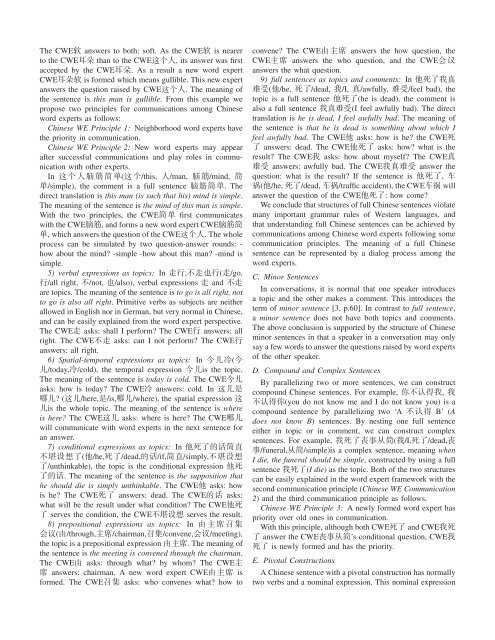Word Expert Translation from German into Chinese in - Knowledge ...
Word Expert Translation from German into Chinese in - Knowledge ...
Word Expert Translation from German into Chinese in - Knowledge ...
Create successful ePaper yourself
Turn your PDF publications into a flip-book with our unique Google optimized e-Paper software.
The CWE� answers to both: soft. As the CWE� is nearer<br />
to the CWE�� than to the CWE���, its answer was first<br />
accepted by the CWE��. As a result a new word expert<br />
CWE��� is formed which means gullible. This new expert<br />
answers the question raised by CWE���. The mean<strong>in</strong>g of<br />
the sentence is this man is gullible. From this example we<br />
propose two pr<strong>in</strong>ciples for communications among <strong>Ch<strong>in</strong>ese</strong><br />
word experts as follows:<br />
<strong>Ch<strong>in</strong>ese</strong> WE Pr<strong>in</strong>ciple 1: Neighborhood word experts have<br />
the priority <strong>in</strong> communication.<br />
<strong>Ch<strong>in</strong>ese</strong> WE Pr<strong>in</strong>ciple 2: New word experts may appear<br />
after successful communications and play roles <strong>in</strong> communication<br />
with other experts.<br />
In � ��� ���(� �/this, �/man, � �/m<strong>in</strong>d, �<br />
�/simple), the comment is a full sentence ����. The<br />
direct translation is this man (is such that his) m<strong>in</strong>d is simple.<br />
The mean<strong>in</strong>g of the sentence is the m<strong>in</strong>d of this man is simple.<br />
With the two pr<strong>in</strong>ciples, the CWE�� first communicates<br />
with the CWE��, and forms a new word expert CWE���<br />
�, which answers the question of the CWE���. The whole<br />
process can be simulated by two question-answer rounds: -<br />
how about the m<strong>in</strong>d? -simple -how about this man? -m<strong>in</strong>d is<br />
simple.<br />
5) verbal expressions as topics: In ��,����(�/go,<br />
�/all right, �/not, �/also), verbal expressions � and ��<br />
are topics. The mean<strong>in</strong>g of the sentence is to go is all right, not<br />
to go is also all right. Primitive verbs as subjects are neither<br />
allowed <strong>in</strong> English nor <strong>in</strong> <strong>German</strong>, but very normal <strong>in</strong> <strong>Ch<strong>in</strong>ese</strong>,<br />
and can be easily expla<strong>in</strong>ed <strong>from</strong> the word expert perspective.<br />
The CWE� asks: shall I perform? The CWE� answers: all<br />
right. The CWE�� asks: can I not perform? The CWE�<br />
answers: all right.<br />
6) Spatial-temporal expressions as topics: In ���(�<br />
�/today,�/cold), the temporal expression ��is the topic.<br />
The mean<strong>in</strong>g of the sentence is today is cold. The CWE��<br />
asks: how is today? The CWE� answers: cold. In ���<br />
��? (��/here,�/is,��/where), the spatial expression �<br />
�is the whole topic. The mean<strong>in</strong>g of the sentence is where<br />
is here? The CWE�� asks: where is here? The CWE��<br />
will communicate with word experts <strong>in</strong> the next sentence for<br />
an answer.<br />
7) conditional expressions as topics: In �������<br />
�����(�/he,��/dead,��/if,��/simply,����<br />
�/unth<strong>in</strong>kable), the topic is the conditional expression ��<br />
���. The mean<strong>in</strong>g of the sentence is the supposition that<br />
he should die is simply unth<strong>in</strong>kable. The CWE� asks: how<br />
is he? The CWE�� answers: dead. The CWE�� asks:<br />
what will be the result under what condition? The CWE��<br />
� serves the condition, the CWE���� serves the result.<br />
8) prepositional expressions as topics: In � � � � �<br />
��(�/through,��/chairman,��/convene,��/meet<strong>in</strong>g),<br />
the topic is a prepositional expression ���. The mean<strong>in</strong>g of<br />
the sentence is the meet<strong>in</strong>g is convened through the chairman.<br />
The CWE� asks: through what? by whom? The CWE�<br />
� answers: chairman. A new word expert CWE��� is<br />
formed. The CWE�� asks: who convenes what? how to<br />
convene? The CWE��� answers the how question, the<br />
CWE� � answers the who question, and the CWE� �<br />
answers the what question.<br />
9) full sentences as topics and comments: In �����<br />
��(�/he, ��/dead, �/I, �/awfully, ��/feel bad), the<br />
topic is a full sentence ���(he is dead), the comment is<br />
also a full sentence ����(I feel awfully bad). The direct<br />
translation is he is dead, I feel awfully bad. The mean<strong>in</strong>g of<br />
the sentence is that he is dead is someth<strong>in</strong>g about which I<br />
feel awfully bad. The CWE� asks: how is he? the CWE�<br />
� answers: dead. The CWE��� asks: how? what is the<br />
result? The CWE� asks: how about myself? The CWE�<br />
�� answers: awfully bad. The CWE���� answer the<br />
question: what is the result? If the sentence is ���, �<br />
�(�/he, ��/dead, ��/traffic accident), the CWE�� will<br />
answer the question of the CWE���: how come?<br />
We conclude that structures of full <strong>Ch<strong>in</strong>ese</strong> sentences violate<br />
many important grammar rules of Western languages, and<br />
that understand<strong>in</strong>g full <strong>Ch<strong>in</strong>ese</strong> sentences can be achieved by<br />
communications among <strong>Ch<strong>in</strong>ese</strong> word experts follow<strong>in</strong>g some<br />
communication pr<strong>in</strong>ciples. The mean<strong>in</strong>g of a full <strong>Ch<strong>in</strong>ese</strong><br />
sentence can be represented by a dialog process among the<br />
word experts.<br />
C. M<strong>in</strong>or Sentences<br />
In conversations, it is normal that one speaker <strong>in</strong>troduces<br />
a topic and the other makes a comment. This <strong>in</strong>troduces the<br />
term of m<strong>in</strong>or sentence [3, p.60]. In contrast to full sentence,<br />
a m<strong>in</strong>or sentence does not have both topics and comments.<br />
The above conclusion is supported by the structure of <strong>Ch<strong>in</strong>ese</strong><br />
m<strong>in</strong>or sentences <strong>in</strong> that a speaker <strong>in</strong> a conversation may only<br />
say a few words to answer the questions raised by word experts<br />
of the other speaker.<br />
D. Compound and Complex Sentences<br />
By paralleliz<strong>in</strong>g two or more sentences, we can construct<br />
compound <strong>Ch<strong>in</strong>ese</strong> sentences. For example, �����, �<br />
����(you do not know me and I do not know you) is a<br />
compound sentence by paralleliz<strong>in</strong>g two ‘A ��� B’ (A<br />
does not know B) sentences. By nest<strong>in</strong>g one full sentence<br />
either <strong>in</strong> topic or <strong>in</strong> comment, we can construct complex<br />
sentences. For example, �������(�/I,��/dead,�<br />
�/funeral,��/simple)is a complex sentence, mean<strong>in</strong>g when<br />
I die, the funeral should be simple, constructed by us<strong>in</strong>g a full<br />
sentence ���(I die) as the topic. Both of the two structures<br />
can be easily expla<strong>in</strong>ed <strong>in</strong> the word expert framework with the<br />
second communication pr<strong>in</strong>ciple (<strong>Ch<strong>in</strong>ese</strong> WE Communication<br />
2) and the third communication pr<strong>in</strong>ciple as follows.<br />
<strong>Ch<strong>in</strong>ese</strong> WE Pr<strong>in</strong>ciple 3: A newly formed word expert has<br />
priority over old ones <strong>in</strong> communication.<br />
With this pr<strong>in</strong>ciple, although both CWE�� and CWE��<br />
� answer the CWE����’s conditional question, CWE�<br />
�� is newly formed and has the priority.<br />
E. Pivotal Constructions<br />
A <strong>Ch<strong>in</strong>ese</strong> sentence with a pivotal construction has normally<br />
two verbs and a nom<strong>in</strong>al expression. This nom<strong>in</strong>al expression

















